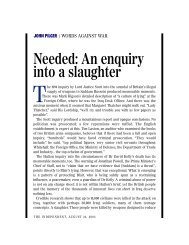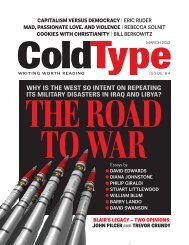You also want an ePaper? Increase the reach of your titles
YUMPU automatically turns print PDFs into web optimized ePapers that Google loves.
118<br />
advertising money sloshing around supporting them. (The<br />
New York Times put the figure at more than $3 billion from<br />
2002 to 2007.)<br />
“There is a credit divide in America that fuels our economic<br />
divide,” I argued in my film, warning of a potential economic<br />
implosion because so many Americans are trapped by a debt<br />
squeeze. I was not alone in projecting a crisis, although my<br />
focus was more on the failure of many media outlets to track<br />
the problem and ask deeper questions.<br />
“Ours has become a nation in which the carrot of instant<br />
affluence is quickly menaced by the harsh stick of bill collectors,<br />
lawsuits, and foreclosures,” I contended. “And yet, this<br />
bubble can burst and has: the slickest of our bankers and the<br />
savviest of our marketers have NOT been able to undo the law<br />
of gravity, that what goes up must come down.”<br />
One didn’t have to be an expert to see the warning signs<br />
which have since led to a massive market meltdown, a collapse<br />
of the subprime mortgage market, bankruptcies by leading<br />
financial lenders, billions of dollars in losses by top banks<br />
and financial lenders, and predictions of more pain to come for<br />
millions of Americans facing foreclosures.<br />
Many in positions of power downplayed the seriousness of<br />
the threat, preferring modest, unrealistic and inaccurate estimates,<br />
perhaps so as not to further panic the markets.<br />
Federal Reserve Chairman Bernanke was among those<br />
who was way off in his prognostications. In July 2007, as Bear<br />
Stearns Hedge Funds were imploding thanks to the mismanagement<br />
by execs who would later be arrested for fraud, he<br />
told Congress that he only expected subprime losses in the $50<br />
to $100 billion range.<br />
Economist Yves Smith responded, “I recall gasping out loud<br />
when I read that, because no one in the private sector had had<br />
loss estimates like that for a while. The lowest estimates I was<br />
seeing around then was $150 billion.” Bernanke was telling
















